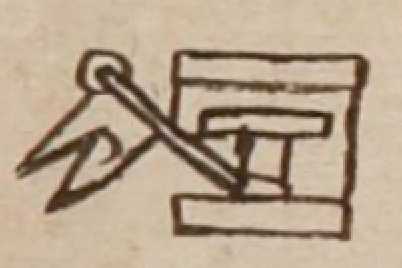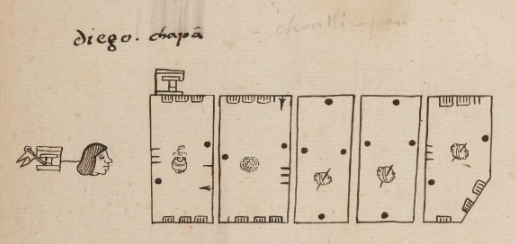Champa (Verg9r)
This black-line drawing of the compound glyph for the personal name Champa (“Toward Home,” attested here as a man’s name) shows a home (chantli) in profile, facing toward the viewer's left. Sticking out of the T-shaped doorway is a two-pointed banner (panitl) on a pole. The pole has a cap. The banner, which shows some European stylistic influence, is a phonetic indicator for the preposition -pa (toward).
Stephanie Wood
The visual representations of house and home are quite similar. It is only the glosses that inform us of the distinction. In this case, the final "n" of the root for chantli has been dropped inadvertently, and in restoring it, since it comes before "p," we have to make it "cham-". The gloss also inadvertently added an "n" at the end of the name, which we are omitting. Intrusive "n's" and the omission of "n" is very common in Nahuatl orthography.
Stephanie Wood
diego.chapā
Diego Champa
Stephanie Wood
1539
Jeff Haskett-Wood
hogar, casa, hacia, nombres de hombres

chan(tli), home, https://nahuatl.wired-humanities.org/content/chantli
pan(itl), flag or banner, https://nahuatl.wired-humanities.org/content/panitl
-pa, toward, https://nahuatl.wired-humanities.org/content/pa-0
Hacia el Hogar
Stephanie Wood
Codex Vergara, folio 9r, https://gallica.bnf.fr/ark:/12148/btv1b84528032/f25.item.zoom
The non-commercial reuse of images from the Bibliothèque nationale de France is free as long as the user is in compliance with the legislation in force and provides the citation: “Source gallica.bnf.fr / Bibliothèque nationale de France” or “Source gallica.bnf.fr / BnF.” We would also appreciate a citation to the Visual Lexicon of Aztec Hieroglyphs, https://aztecglyphs.wired-humanities.org/.





